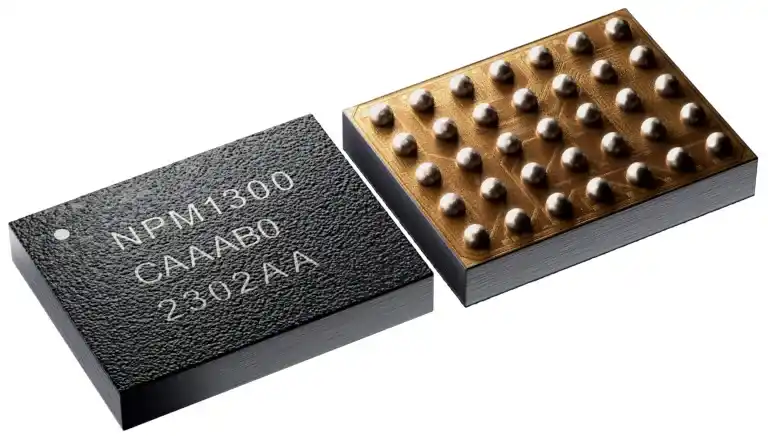
Nordic Semiconductor has launched its highly integrated nPM1300 power management IC (PMIC), comprised of two ultra-efficient buck converters, two load switches/low dropout voltage converters (LDOs) and integrated battery charging. Targeting battery-operated applications, such as advanced wearables and portable medical devices, the PMIC reduces the bill of materials by combining circuitry that typically requires five or more discrete components into a single chip, said Nordic. An evaluation kit is also available.
A key feature of the PMIC is its unique system management features and accurate fuel gauging for low-power wireless applications. This includes an algorithm-based fuel gauge functionality that uses voltage, current and temperature monitoring for higher accuracy than voltage-based fuel gauges, according to the company. It also maintains the PMIC’s own power consumption lower than coulomb counter-type fuel gauges. Nordic said it is the first company to achieve this balance between high accuracy and low power consumption.
The nPM1300 operates from either a 4.0 to 5.5-V external power supply or a battery voltage down to 2.4 V. It features four controllable power rails. Two power rails are regulated by separate DC/DC buck converters that are configurable between 1.0 and 3.3 V and up to 200-mA maximum current, while the other two power rails operate as load switches, switching currents of up to 100 mA from external sources, which can also operate as LDOs when powered directly by the nPM1300.
When operating as LDOs, these power rail outputs are configurable between 1.0 and 3.3 V with a maximum output current of 50 mA, said Nordic, and the unregulated input voltage is also available as an output from the nPM1300.
The nPM1300 charges single-cell Li-ion, Li-poly and LiFePO4 batteries with a linear charging module that supports up to 800 mA charge current and programmable 3.5 to 4.45-V termination voltage. The battery charger features automatic thermal regulation with programmable maximum chip temperature during charging.
Other features include three LED drivers, five GPIOs, USB port detection with automatic current limits of 100 mA or 500 mA through standard USB or up to 1500 mA through USB-C, dynamic power path management, which automatically switches to battery power if mains power is removed and ultra-low current ship- and hibernate-mode with a programmable wake-up timer.
The PMIC also features an I2C-compatible two-wire interface (TWI) for configuration of advanced system management functions, including integrated hard reset functionality from one or two buttons, battery fuel gauging, system-level watchdog, power loss warning and recovery from failed boot.
The nPM1300 evaluation kit (EK) and the nPM PowerUP PC app make it easier to evaluate, configure and implement the nPM1300 without having to write any code, said Nordic. It works by connecting the EK to the nPM PowerUP app found in the nRF Connect for Desktop (development software for Nordic products), where the settings for the nPM1300 can be configured through an intuitive graphical user interface (GUI). The configuration can then be ported to the system-on-chip or microcontroller used for the IoT application.
The EK features two USB-C connectors for data and power connection, JST battery connectors for batteries with or without an internal NTC thermistor and male pin headers for access to all the nPM1300’s connections. It also includes three LEDs and four pushbuttons that can be used to evaluate the GPIO and LED driver functionality of the PMIC.
Samples of the nPM1300 PMIC in QFN and CSP packages are available now through Nordic sales, followed by mass production in October 2023. The nPM1300 EK is available now through Nordic’s distribution partners.


